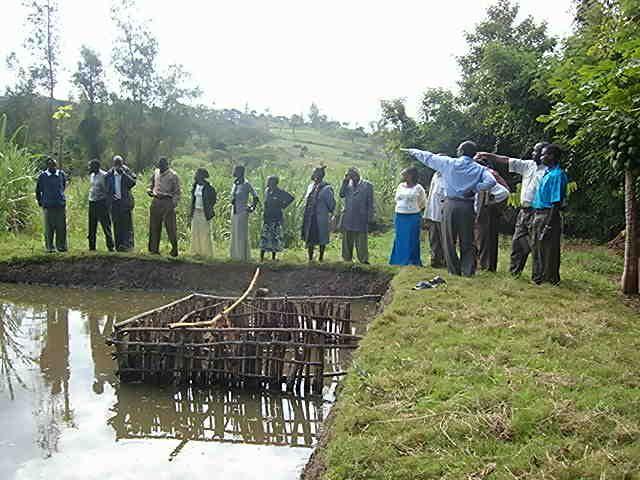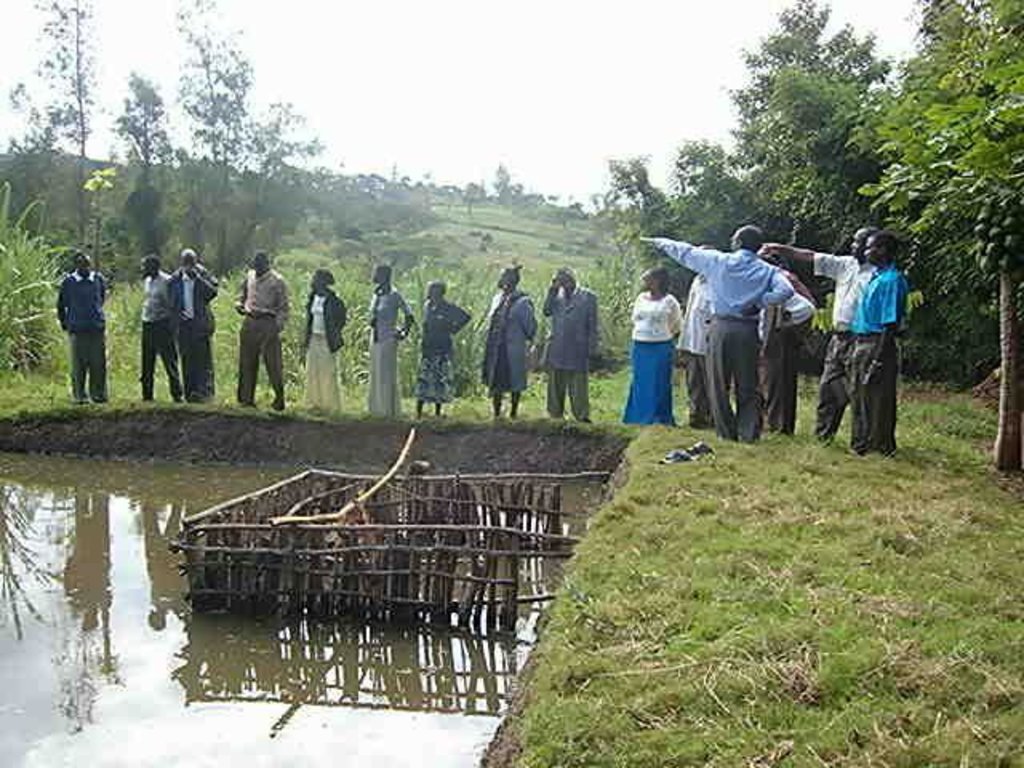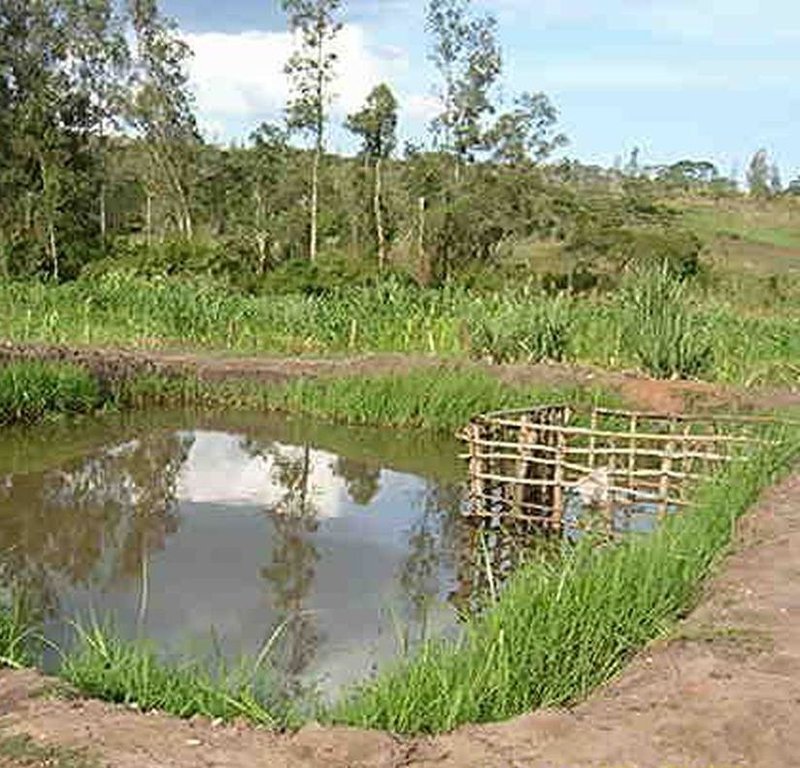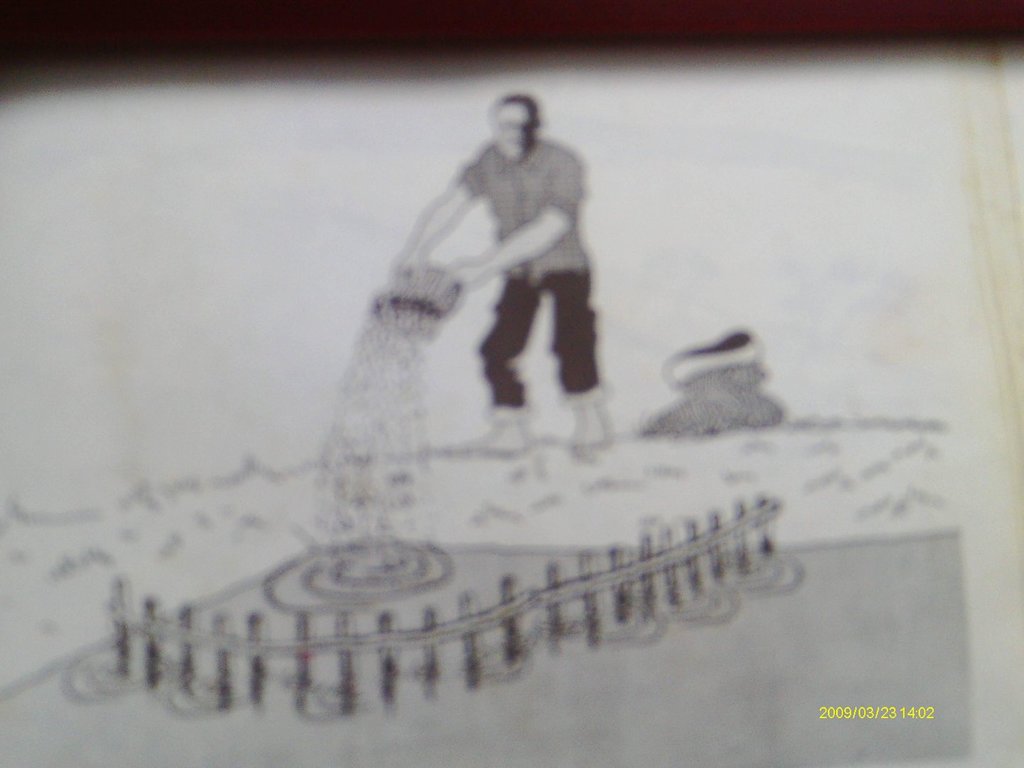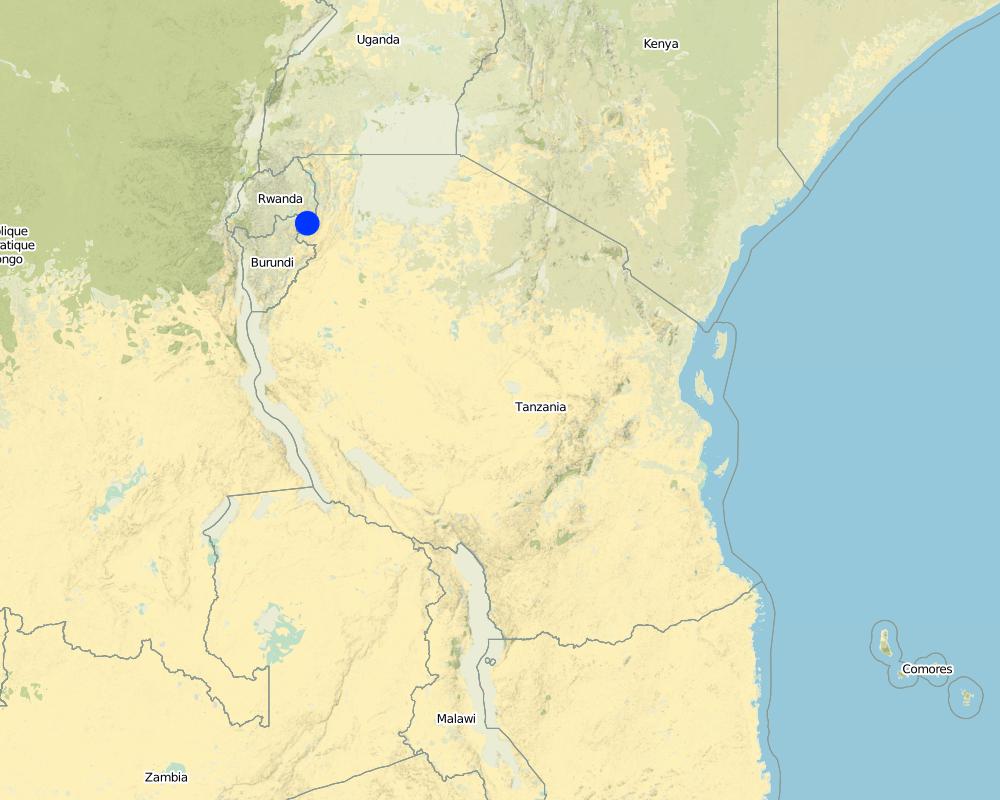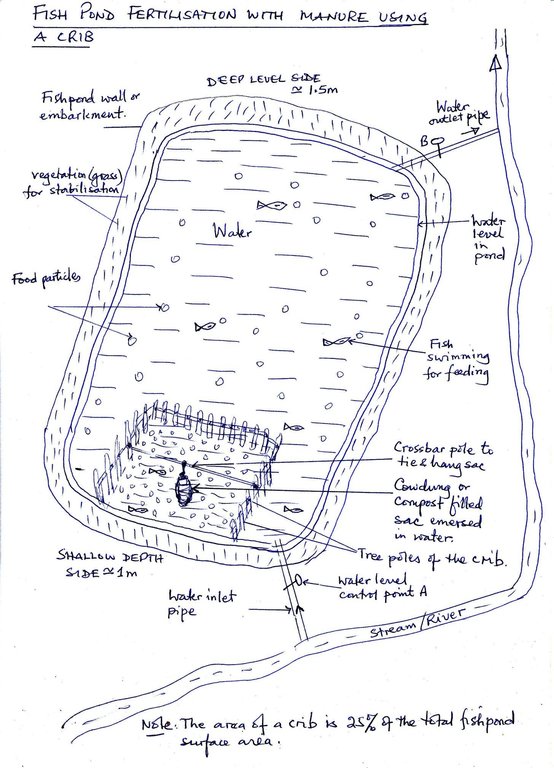FISH POND MANURING USING CRIB METHOD [坦桑尼亚联合共和国]
- 创建:
- 更新:
- 编制者: Philip Ileta
- 编辑者: –
- 审查者: David Streiff, Alexandra Gavilano
UFUGAJI WA SAMAKI KWENYE BWAWA
technologies_1154 - 坦桑尼亚联合共和国
查看章节
全部展开 全部收起1. 一般信息
1.2 参与该技术评估和文件编制的资源人员和机构的联系方式
SLM专业人员:
Zawadi Waziri
Enviroment Ngara
坦桑尼亚联合共和国
SLM专业人员:
Mugishagwe Wilson
Forestry Ngara
坦桑尼亚联合共和国
SLM专业人员:
Josephat Sangatati
Livestock Ngara
坦桑尼亚联合共和国
有助于对技术进行记录/评估的机构名称(如相关)
Ngara District Council (Ngara District Council) - 坦桑尼亚联合共和国1.3 关于使用通过WOCAT记录的数据的条件
编制者和关键资源人员接受有关使用通过WOCAT记录数据的条件。:
是
2. SLM技术的说明
2.1 技术简介
技术定义:
This is a practice of fish farming whereby farmers excavate ponds ,fill in fresh water,stock-in fish fingerings and manage them to mature or marketable size
2.2 技术的详细说明
说明:
Select a suitable area/site with permanent water source or alongside the flowing river/stream preferably with a clay soil and excavate a suitable sized pond(30mx20m)and a depth of 1,5-2m at the upper and lower side respectively. A crib of 4 m2 for application of manure is constructed using short tree poles at the shallow portion of the pond before filling in water and introducing fish fingerings
Purpose of the Technology: The crib provides an area where Farm yard manure or compost is put to decompose and thereby stimulate the growth of fish foods (phytoplanktons).
Establishment / maintenance activities and inputs: ESTABLISHMENT
-Selection of suitable area and pegging to required size/area
-Excavations to suitable depth
-Dig inlet canal from the water source through the shallow side and outlet canal from the deeper portion of the pond back to the main stream (Alternatively use small metal pipes,bamboo or plastic pipes for inlets and outlets)
-Compact the embankment and stabilize soil by planting suitable grass species such as vetiva spp etc
-Cut 2.5m long strong poles and construct a crib for manure application
-Spread manure at the bottom of the pond and wait for weeds growth (normally 2 weeks)
-Fill in water and stock in fingerings( 1 fingering per sq meter)
-Protect the pond by fencing preferably planting around live fence trees such as Dovyalis caffra,Pthecelobium dulce etc
MAINTANANCE
-Regular cleaning of the pond,and weeding the sorounding environment
-Feeeding with extra foods such as rice/maize brun,rice husks,chopped vegetables,pumpkins and potatoes etc
-Weekly application of farm yard manure or compost(1 tin 15-20 kg) by putting and tying by hanging a sac full in a crib.
-Shaking once daily the hanging sac while in water to release nutrients
Natural / human environment: The pond site should be easily accesible and where possible near homesteads for security purpose
-Harvesting may done by draining the water from the pond, using a seine net,and catch the desired size of fish while returning the young fish to continue growing
In good pond management/feeding farmers are able to harvest every after six months
2.3 技术照片
2.5 已应用该技术的、本评估所涵盖的国家/地区/地点
国家:
坦桑尼亚联合共和国
区域/州/省:
Tanzania
有关地点的进一步说明:
Ngara District Council
具体说明该技术的分布:
- 均匀地分布在一个区域
如果不知道精确的区域,请注明大致覆盖的区域:
- < 0.1 平方千米(10 公顷)
注释:
Total area covered by the SLM Technology is 0.06 ha.
The group owns a fish pond of size 30mx20m in a wetland located in Kasulo village and is stocked with Tilapia spp fingerings
Map
×2.6 实施日期
如果不知道确切的年份,请说明大概的日期:
- 10-50年前
2.7 技术介绍
详细说明该技术是如何引入的:
- 通过项目/外部干预
注释(项目类型等):
fish farming in Ngara has been supported since the 1980s by UNICEF,DRDPS and recently by DANIDA through NGOs(REDESO and TCRS)
3. SLM技术的分类
3.1 该技术的主要目的
- 改良生产
- 创造有益的经济影响
3.2 应用该技术的当前土地利用类型

水道、水体、湿地
- 池塘、大坝
注释:
Major land use problems (compiler’s opinion): -less utilisation of wetlands resources to contribute in improving (livelihood) nutrition and groups/huosehold income
-some fish species (larvifish)may be stocked in ponds to feed on diseases vectors such as mosquitoe larva and reduce malaria incidences
Major land use problems (land users’ perception): To obtain fish for food and surplus harvest for income
Type of cropping system and major crops comments: farmers cultivate small plots of vegetables,sweet potatoes in valleys near fish ponds and chop them to supplement fish meals
3.4 供水
注释:
Number of growing seasons per year:
2
Specify:
Longest growing period in days: 120; Longest growing period from month to month: October to January; Second longest growing period in days: 90; Second longest growing period from month to month: March to May
3.5 该技术所属的SLM组
- 养蜂、养殖业、家禽业、养兔业、养蚕业等
3.6 包含该技术的可持续土地管理措施

农艺措施
- A6:残株管理
- A7:其它

植物措施
- V5:其它

结构措施
- S5:大坝、集水斗、水池

管理措施
- M5:物种组成的控制/变化
注释:
Secondary measures: management measures
Specification of other agronomic measures: water storage for fish culture
Type of agronomic measures: manure / compost / residues
Type of vegetative measures: scattered / dispersed
3.7 该技术强调的主要土地退化类型

生物性退化
- Bh:栖息地丧失
注释:
Secondary types of degradation addressed: Bh: loss of habitats
Main causes of degradation: other human induced causes (specify) (over exploitation of fish in natural water bodies)
Secondary causes of degradation: Heavy / extreme rainfall (intensity/amounts) (Causing siltation,flooding of already constructed fish ponds), other natural causes (avalanches, volcanic eruptions, mud flows, highly susceptible natural resources, extreme topography, etc.) specify (blocking of water channels, ponds due to mud)
3.8 防止、减少或恢复土地退化
具体数量名该技术与土地退化有关的目标:
- 防止土地退化
4. 技术规范、实施活动、投入和成本
4.1 该技术的技术图纸
技术规范(与技术图纸相关):
Fish pond fertilization with manure using a crib
Location: yyy village. Ngara District Council/Tanzania
Date: 15 May 2012
Technical knowledge required for field staff / advisors: moderate (Once the fishpond is established,the extension kit requires regular monitoring for improvement of fish feeds and outbreak of diseases which are relatively few compared to other livestocks such as pok)
Technical knowledge required for land users: moderate (Following the fish pond manual developed by the district is simple with regard to pond management and feeding regimes)
Main technical functions: increase in nutrient availability (supply, recycling,…)
Secondary technical functions: increase in organic matter, promotion of vegetation species and varieties (quality, eg palatable fodder)
Manure / compost / residues
Material/ species: cowdung
Quantity/ density: 50 kgs
Remarks: applied in crib once weekly per pond
Scattered / dispersed
Vegetative material: G : grass
Number of plants per (ha): 300
Vertical interval between rows / strips / blocks (m): seedlings
Vertical interval within rows / strips / blocks (m): 0.1
Width within rows / strips / blocks (m): 0.1
Grass species: vetiva planted to stablise pond embarkments
Dam/ pan/ pond
Depth of ditches/pits/dams (m): 1.5
Width of ditches/pits/dams (m): 20
Length of ditches/pits/dams (m): 30
Reshaping surface
Length of ditches/pits/dams (m): 2
Construction material (earth): The pond has the deeper side 1.5m and shallower side 1.0m,with the top earth compacted 2m wide
Vegetation is used for stabilisation of structures.
Change of land use practices / intensity level: Wetlands were marginally used only for dry season agriculture and some vegatable growing-now aquaculture intergration adding productive value to it
Control / change of species composition: Most farmers preferered Tilapia nilotica for stocking in fishponds,phytoplanktons growth promoted
作者:
Ileta Philip, c/o DED Ngara District Council
4.2 有关投入和成本计算的一般信息
具体说明成本和投入是如何计算的:
- 每个技术单元
指定单位:
Fishpond
指定单位面积(如相关):
30m x 20m
其它/国家货币(具体说明):
Tanzania shilling
如相关,注明美元与当地货币的汇率(例如1美元=79.9巴西雷亚尔):1美元=:
1600.0
注明雇用劳工的每日平均工资成本:
1.25
4.3 技术建立活动
| 活动 | 时间(季度) | |
|---|---|---|
| 1. | Buying of vetiva | during the rains |
| 2. | Planting of vetiva on embarkments | during rains |
| 3. | Allignment and layout of pond | before rains |
| 4. | Excavation of the pond | before rains |
| 5. | Raising embarkments,compaction construction inlets and outlets | before rains |
| 6. | Collect cow dung | |
| 7. | Purchase fish fingerings | |
| 8. | Purchase tools |
注释:
Lifespan of dung, fish fingerings and tools: 3 years
4.4 技术建立所需要的费用和投入
| 对投入进行具体说明 | 单位 | 数量 | 单位成本 | 每项投入的总成本 | 土地使用者承担的成本% | |
|---|---|---|---|---|---|---|
| 劳动力 | Planting of vetiva on embarkments | persons/day | 2.0 | 1.25 | 2.5 | 100.0 |
| 劳动力 | Allignment and layout of pond | persons/day | 2.0 | 1.25 | 2.5 | 50.0 |
| 劳动力 | Excavation of the pond | persons/day | 120.0 | 1.88 | 225.6 | 100.0 |
| 劳动力 | Raising embarkments,compaction construction inlets and outlets | persons/day | 3.0 | 1.25 | 3.75 | 100.0 |
| 设备 | Fish fingerings | pieces | 1000.0 | 0.06 | 60.0 | 20.0 |
| 设备 | Tools | pieces | 4.0 | 12.5 | 50.0 | 20.0 |
| 设备 | Vetiva | pieces | 300.0 | 0.16666 | 50.0 | 100.0 |
| 肥料和杀菌剂 | Cowdung | kg | 50.0 | 1.25 | 62.5 | 100.0 |
| 技术建立所需总成本 | 456.85 | |||||
| 技术建立总成本,美元 | 0.29 | |||||
注释:
Duration of establishment phase: 4 month(s)
4.5 维护/经常性活动
| 活动 | 时间/频率 | |
|---|---|---|
| 1. | Application of cowdung | weekly |
| 2. | Application of extra feeds | fortnight |
| 3. | Clean weeding | monthly |
| 4. | Trimming the live fence,weeding and monitoring | dry seson |
| 5. | Repairing of walls | after heavy storms |
| 6. | Management of fingerings -monitoring of growth,control of overpopulation | monthly |
| 7. | Cowdung application and manipulation for nutrients release | weekly |
4.6 维护/经常性活动所需要的费用和投入(每年)
| 对投入进行具体说明 | 单位 | 数量 | 单位成本 | 每项投入的总成本 | 土地使用者承担的成本% | |
|---|---|---|---|---|---|---|
| 劳动力 | Clean weeding | persons/day | 2.0 | 1.25 | 2.5 | 100.0 |
| 劳动力 | Trimming the live fence,weeding and monitoring | persons/day | 2.0 | 1.25 | 2.5 | 100.0 |
| 劳动力 | Repairing of walls | persons/day | 2.0 | 1.25 | 2.5 | 100.0 |
| 劳动力 | Management of fingerings | persons/day | 4.0 | 1.6 | 6.4 | 100.0 |
| 设备 | Extra feeds (maize and ricebran) | kg | 10.0 | 1.88 | 18.8 | 100.0 |
| 肥料和杀菌剂 | Cowdung | kg | 50.0 | 1.25 | 62.5 | 100.0 |
| 其它 | Labour: Cowdung application and manipulation for nutrients release | persons/day | 1.0 | 1.25 | 1.25 | 100.0 |
| 技术维护所需总成本 | 96.45 | |||||
| 技术维护总成本,美元 | 0.06 | |||||
注释:
the costs are calculated per fish pond of size 20m width,30m length and depth 1.5m
4.7 影响成本的最重要因素
描述影响成本的最决定性因素:
labour especially during excavations(establishment phase)
cowdung when the land user buys instead of obtaining from the homestead/kraal
5. 自然和人文环境
5.1 气候
年降雨量
- < 250毫米
- 251-500毫米
- 501-750毫米
- 751-1,000毫米
- 1,001-1,500毫米
- 1,501-2,000毫米
- 2,001-3,000毫米
- 3,001-4,000毫米
- > 4,000毫米
指定年平均降雨量(若已知),单位为mm:
950.00
有关降雨的规范/注释:
Length of dry periods 4 months
Main rain season Oct to Dec/January, Second season March to Mid May
农业气候带
- 半湿润
Thermal climate class: tropics. Hot during the days slighly cold nights,avarage temp range18-30C
5.2 地形
平均坡度:
- 水平(0-2%)
- 缓降(3-5%)
- 平缓(6-10%)
- 滚坡(11-15%)
- 崎岖(16-30%)
- 陡峭(31-60%)
- 非常陡峭(>60%)
地形:
- 高原/平原
- 山脊
- 山坡
- 山地斜坡
- 麓坡
- 谷底
垂直分布带:
- 0-100 m a.s.l.
- 101-500 m a.s.l.
- 501-1,000 m a.s.l.
- 1,001-1,500 m a.s.l.
- 1,501-2,000 m a.s.l.
- 2,001-2,500 m a.s.l.
- 2,501-3,000 m a.s.l.
- 3,001-4,000 m a.s.l.
- > 4,000 m a.s.l.
说明该技术是否专门应用于:
- 凹陷情况
5.3 土壤
平均土层深度:
- 非常浅(0-20厘米)
- 浅(21-50厘米)
- 中等深度(51-80厘米)
- 深(81-120厘米)
- 非常深(> 120厘米)
土壤质地(表土):
- 中粒(壤土、粉土)
- 细粒/重质(粘土)
表土有机质:
- 高(>3%)
- 中(1-3%)
如有可能,附上完整的土壤描述或具体说明可用的信息,例如土壤类型、土壤酸碱度、阳离子交换能力、氮、盐度等。:
Soil depth on average: Shallow (ranked 1, loamy to heavy clayey basement) and moderately deep (ranked 2)
Soil fertility: Medium (ranked 1), low (ranked 2) and high (ranked 3)
Topsoil organic matter is medium (ranked 1) and high (ranked 2)
Soil drainage / infiltration is poor and retains water in pond permanently, but medium in severe dry spell and water level decrease to half pond depth.
Soil water storage capacity is high near wetlands and permanent streams. Sometimes also very high
5.4 水资源可用性和质量
地下水位表:
表面上
地表水的可用性:
好
水质(未处理):
仅供农业使用(灌溉)
关于水质和水量的注释和进一步规范:
Availability of surface water: Good (ranked 1) and excess (ranked 2, the site of the pond is located such that at maximum flooding it shoul d not be reached by flood water to prevent fish escape/overflow)
Water quality (untreated): For agricultural use only: Wetlands used for dry season farming and small horticultural gardens. Farmers fetch water in the streams due to unavailability of safe water points
5.5 生物多样性
物种多样性:
- 低
关于生物多样性的注释和进一步规范:
Decreasing rapidly due to pollution of water sources, deforeatstion and overexploiation of natural fish stocks
5.6 应用该技术的土地使用者的特征
生产系统的市场定位:
- 生计(自给)
- 混合(生计/商业)
非农收入:
- > 收入的50%
相对财富水平:
- 贫瘠
- 平均水平
个人或集体:
- 团体/社区
机械化水平:
- 手工作业
性别:
- 女人
- 男人
说明土地使用者的其他有关特征:
Difference in the involvement of women and men: Excavations usually by men labour but for maintanance activitiies women play increasing roles
Population density: 10-50 persons/km2
60% of the land users are average wealthy.
20% of the land users are poor.
Off-farm income specification: Most of the farmers with ponds have livestock and apply cow dung instaed of compost
Market orientation of production system: Mixed (farmers sell some surplus fish although productivity still below avarage)
5.7 应用该技术的土地使用者使用的平均土地面积
- < 0.5 公顷
- 0.5-1 公顷
- 1-2 公顷
- 2-5公顷
- 5-15公顷
- 15-50公顷
- 50-100公顷
- 100-500公顷
- 500-1,000公顷
- 1,000-10,000公顷
- > 10,000公顷
这被认为是小规模、中规模还是大规模的(参照当地实际情况)?:
- 小规模的
5.8 土地所有权、土地使用权和水使用权
土地所有权:
- 社区/村庄
- 团体
土地使用权:
- 社区(有组织)
用水权:
- 自由进入(无组织)
注释:
water use is free for use by all community members especially for agricultural activities
5.9 进入服务和基础设施的通道
健康:
- 贫瘠
- 适度的
- 好
教育:
- 贫瘠
- 适度的
- 好
技术援助:
- 贫瘠
- 适度的
- 好
就业(例如非农):
- 贫瘠
- 适度的
- 好
市场:
- 贫瘠
- 适度的
- 好
能源:
- 贫瘠
- 适度的
- 好
道路和交通:
- 贫瘠
- 适度的
- 好
饮用水和卫生设施:
- 贫瘠
- 适度的
- 好
金融服务:
- 贫瘠
- 适度的
- 好
6. 影响和结论性说明
6.1 该技术的现场影响
社会经济效应
生产
饲料生产
注释/具体说明:
Phytoplanktons feeds
生产区域
SLM之前的数量:
0
SLM之后的数量:
0.06
注释/具体说明:
This is the surface area of the pond
收入和成本
农业收入
SLM之前的数量:
100
SLM之后的数量:
375
注释/具体说明:
Market for fish is available when good size
社会文化影响
食品安全/自给自足
注释/具体说明:
From increased income
健康状况
注释/具体说明:
Animal protein source menu, but malaria and bilhazia vectors when ponds are not well kept/managed
livelihood and human well-being
注释/具体说明:
When the suitable species of fish is stocked and proper fish pond management procedures adhered to -the harvest are high-at least once to twice per year-but this requires high initial and maintanance capital -routine extension from aquaculture experts is highly needed to enable farmers realise profits
生态影响
土壤
土壤有机物/地下C
注释/具体说明:
From decomposition of cow dung
生物多样性:植被、动物
植物多样性
注释/具体说明:
Phytoplanktons and water weeds
栖息地多样性
注释/具体说明:
Other water fauna and flora which are not predators may be allowed to flourish
6.2 该技术的场外影响已经显现
下游洪水
注释/具体说明:
Water retained in ponds when adopted farmers increase
6.3 技术对渐变气候以及与气候相关的极端情况/灾害的暴露和敏感性(土地使用者认为的极端情况/灾害)
渐变气候
渐变气候
| 季节 | 增加或减少 | 该技术是如何应对的? | |
|---|---|---|---|
| 年温度 | 增加 | 不好 |
气候有关的极端情况(灾害)
气候灾害
| 该技术是如何应对的? | |
|---|---|
| 干旱 | 不好 |
水文灾害
| 该技术是如何应对的? | |
|---|---|
| 比较和缓的(河道)洪水 | 不好 |
注释:
The productivity of the fish pond is determined by many factors including the selected species of fish,the feeding levels and the temperature of water. Most tropical fish species grows well when the temperature of the pond water remains warm
6.4 成本效益分析
技术收益与技术建立成本相比如何(从土地使用者的角度看)?
短期回报:
积极
长期回报:
积极
技术收益与技术维护成本/经常性成本相比如何(从土地使用者的角度看)?
短期回报:
积极
长期回报:
积极
注释:
Initial establishment capital high
Cow dung may be obtained free from kraal or altenative use compost
manure
6.5 技术采用
- 单例/实验
如若可行,进行量化(住户数量和/或覆盖面积):
3 households
在所有采用这项技术的人当中,有多少人是自发的,即未获得任何物质奖励/付款?:
- 0-10%
注释:
3 land user families have adopted the Technology with external material support
Comments on acceptance with external material support: The fish ponds project attracted many families to engage in the activities,the constraints were high capital investments and poor pond managent
There is a little trend towards spontaneous adoption of the Technology
Comments on adoption trend: especially for well off farmers with land holdings near wetlands and streams
6.7 该技术的优点/长处/机会
| 土地使用者眼中的长处/优势/机会 |
|---|
|
Availability of permanent water sources especially streams How can they be sustained / enhanced? Conservation bylaws enforced on bufferzones |
| 编制者或其他关键资源人员认为的长处/优势/机会 |
|---|
|
Availability of permanent water sources especially streams How can they be sustained / enhanced? Conservation bylaws enforced on bufferzones |
|
Farmers owns cattle/shorts How can they be sustained / enhanced? Enhance crop and livestock intergration |
|
Wetlands are owned comunally and by village governments How can they be sustained / enhanced? Bylaws enforcement to prevent encroachment and pollution |
6.8 技术的弱点/缺点/风险及其克服方法
| 土地使用者认为的弱点/缺点/风险 | 如何克服它们? |
|---|---|
| High capital investments | Family oriented groups have some success ,to think of some subsidies throgh government or simple credit schemes |
| 编制者或其他关键资源人员认为的弱点/缺点/风险 | 如何克服它们? |
|---|---|
| High capital investments | Group approach used -although many groups fail to sustain the ponds |
链接和模块
全部展开 全部收起链接
无链接
模块
无模块


